Business Environment Report: Analysis of Organisations and Functions
VerifiedAdded on 2020/06/05
|9
|2314
|52
Report
AI Summary
This report provides a comprehensive analysis of the business environment, focusing on different types of organisations including public, private, and voluntary sectors, with NATWEST bank as a primary case study. It explores the size, scope, and purpose of these organisations, highlighting their objectives and functions. The report delves into the relationship between various organisational functions such as Human Resources, Finance, Administration, and Marketing & Sales, and how they contribute to achieving overall business objectives. Furthermore, it discusses the impact of the macro environment on businesses, incorporating SWOT and PESTEL analyses to assess the business landscape. The report concludes by emphasizing the interconnectedness of departmental goals with organisational aims and objectives, offering insights into how these analyses can inform the development of new structures or business expansions.
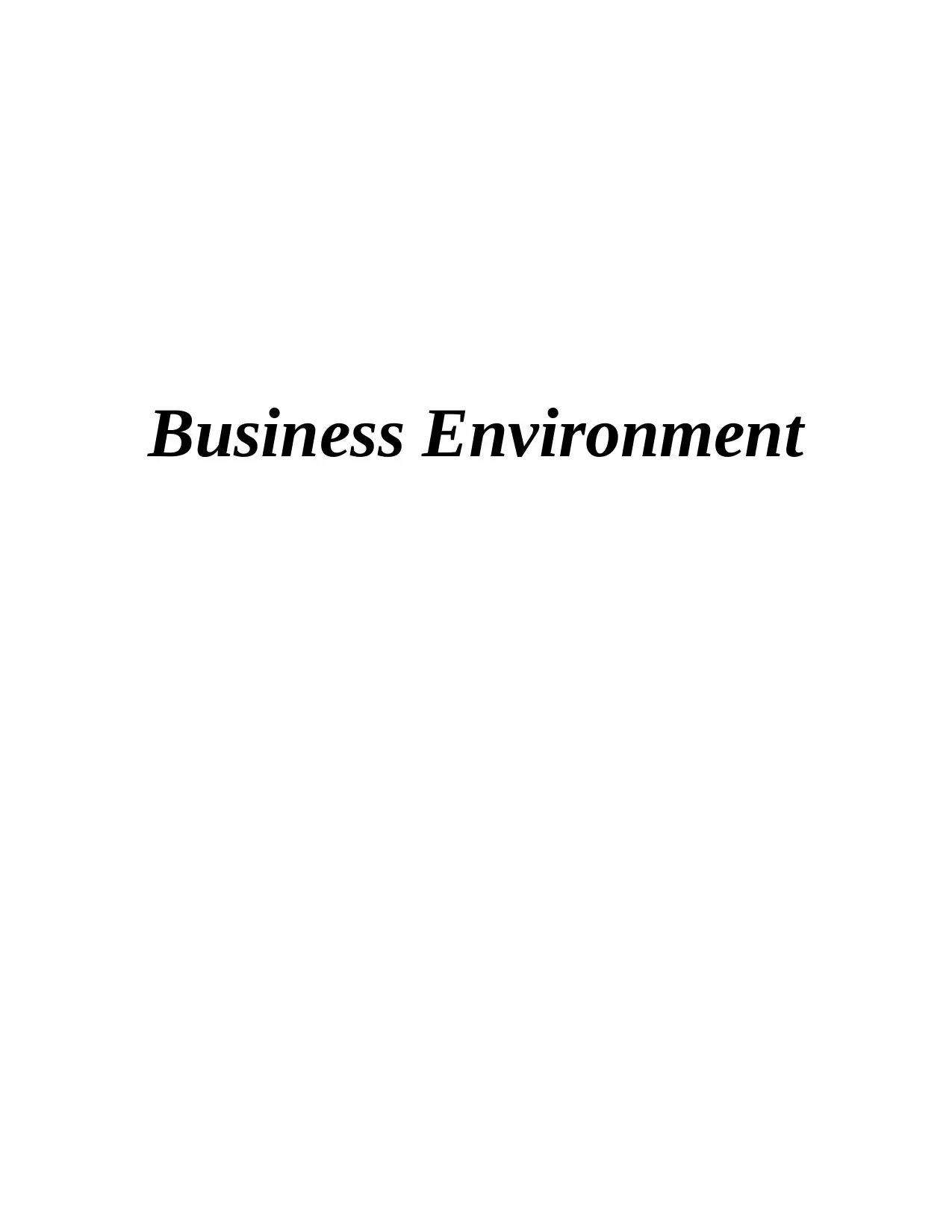
Business Environment
Paraphrase This Document
Need a fresh take? Get an instant paraphrase of this document with our AI Paraphraser
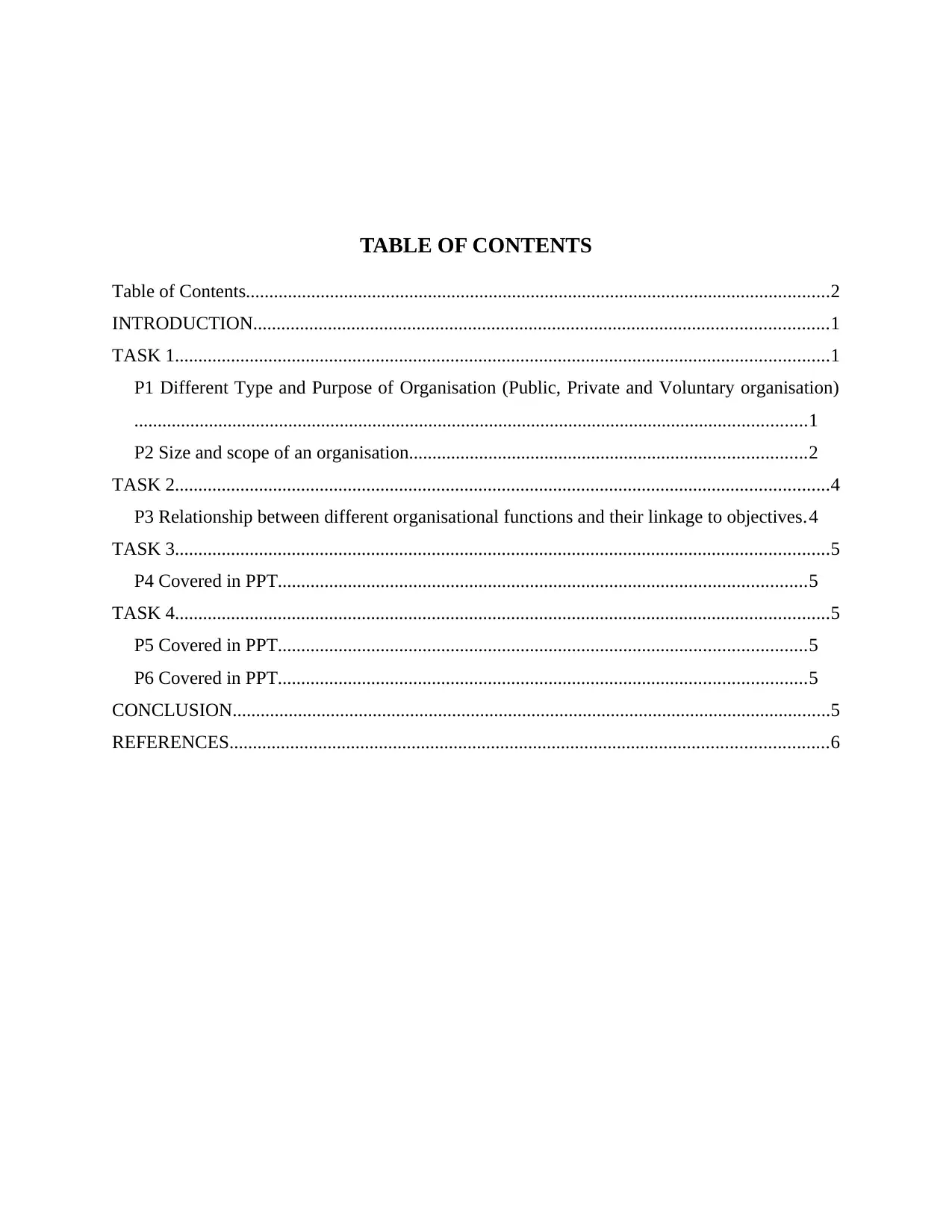
TABLE OF CONTENTS
Table of Contents.............................................................................................................................2
INTRODUCTION...........................................................................................................................1
TASK 1............................................................................................................................................1
P1 Different Type and Purpose of Organisation (Public, Private and Voluntary organisation)
................................................................................................................................................1
P2 Size and scope of an organisation.....................................................................................2
TASK 2............................................................................................................................................4
P3 Relationship between different organisational functions and their linkage to objectives.4
TASK 3............................................................................................................................................5
P4 Covered in PPT.................................................................................................................5
TASK 4............................................................................................................................................5
P5 Covered in PPT.................................................................................................................5
P6 Covered in PPT.................................................................................................................5
CONCLUSION................................................................................................................................5
REFERENCES................................................................................................................................6
Table of Contents.............................................................................................................................2
INTRODUCTION...........................................................................................................................1
TASK 1............................................................................................................................................1
P1 Different Type and Purpose of Organisation (Public, Private and Voluntary organisation)
................................................................................................................................................1
P2 Size and scope of an organisation.....................................................................................2
TASK 2............................................................................................................................................4
P3 Relationship between different organisational functions and their linkage to objectives.4
TASK 3............................................................................................................................................5
P4 Covered in PPT.................................................................................................................5
TASK 4............................................................................................................................................5
P5 Covered in PPT.................................................................................................................5
P6 Covered in PPT.................................................................................................................5
CONCLUSION................................................................................................................................5
REFERENCES................................................................................................................................6
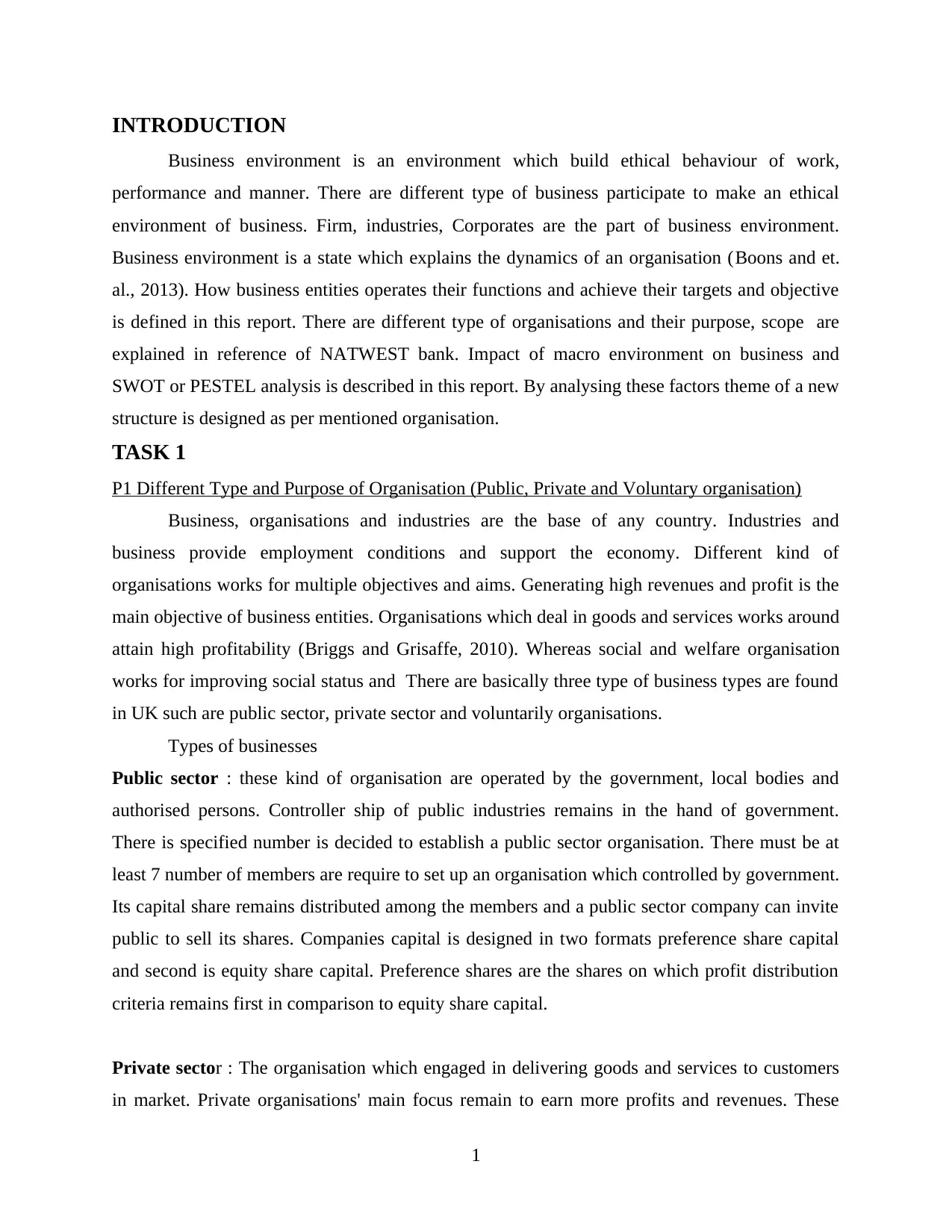
INTRODUCTION
Business environment is an environment which build ethical behaviour of work,
performance and manner. There are different type of business participate to make an ethical
environment of business. Firm, industries, Corporates are the part of business environment.
Business environment is a state which explains the dynamics of an organisation (Boons and et.
al., 2013). How business entities operates their functions and achieve their targets and objective
is defined in this report. There are different type of organisations and their purpose, scope are
explained in reference of NATWEST bank. Impact of macro environment on business and
SWOT or PESTEL analysis is described in this report. By analysing these factors theme of a new
structure is designed as per mentioned organisation.
TASK 1
P1 Different Type and Purpose of Organisation (Public, Private and Voluntary organisation)
Business, organisations and industries are the base of any country. Industries and
business provide employment conditions and support the economy. Different kind of
organisations works for multiple objectives and aims. Generating high revenues and profit is the
main objective of business entities. Organisations which deal in goods and services works around
attain high profitability (Briggs and Grisaffe, 2010). Whereas social and welfare organisation
works for improving social status and There are basically three type of business types are found
in UK such are public sector, private sector and voluntarily organisations.
Types of businesses
Public sector : these kind of organisation are operated by the government, local bodies and
authorised persons. Controller ship of public industries remains in the hand of government.
There is specified number is decided to establish a public sector organisation. There must be at
least 7 number of members are require to set up an organisation which controlled by government.
Its capital share remains distributed among the members and a public sector company can invite
public to sell its shares. Companies capital is designed in two formats preference share capital
and second is equity share capital. Preference shares are the shares on which profit distribution
criteria remains first in comparison to equity share capital.
Private sector : The organisation which engaged in delivering goods and services to customers
in market. Private organisations' main focus remain to earn more profits and revenues. These
1
Business environment is an environment which build ethical behaviour of work,
performance and manner. There are different type of business participate to make an ethical
environment of business. Firm, industries, Corporates are the part of business environment.
Business environment is a state which explains the dynamics of an organisation (Boons and et.
al., 2013). How business entities operates their functions and achieve their targets and objective
is defined in this report. There are different type of organisations and their purpose, scope are
explained in reference of NATWEST bank. Impact of macro environment on business and
SWOT or PESTEL analysis is described in this report. By analysing these factors theme of a new
structure is designed as per mentioned organisation.
TASK 1
P1 Different Type and Purpose of Organisation (Public, Private and Voluntary organisation)
Business, organisations and industries are the base of any country. Industries and
business provide employment conditions and support the economy. Different kind of
organisations works for multiple objectives and aims. Generating high revenues and profit is the
main objective of business entities. Organisations which deal in goods and services works around
attain high profitability (Briggs and Grisaffe, 2010). Whereas social and welfare organisation
works for improving social status and There are basically three type of business types are found
in UK such are public sector, private sector and voluntarily organisations.
Types of businesses
Public sector : these kind of organisation are operated by the government, local bodies and
authorised persons. Controller ship of public industries remains in the hand of government.
There is specified number is decided to establish a public sector organisation. There must be at
least 7 number of members are require to set up an organisation which controlled by government.
Its capital share remains distributed among the members and a public sector company can invite
public to sell its shares. Companies capital is designed in two formats preference share capital
and second is equity share capital. Preference shares are the shares on which profit distribution
criteria remains first in comparison to equity share capital.
Private sector : The organisation which engaged in delivering goods and services to customers
in market. Private organisations' main focus remain to earn more profits and revenues. These
1
⊘ This is a preview!⊘
Do you want full access?
Subscribe today to unlock all pages.

Trusted by 1+ million students worldwide
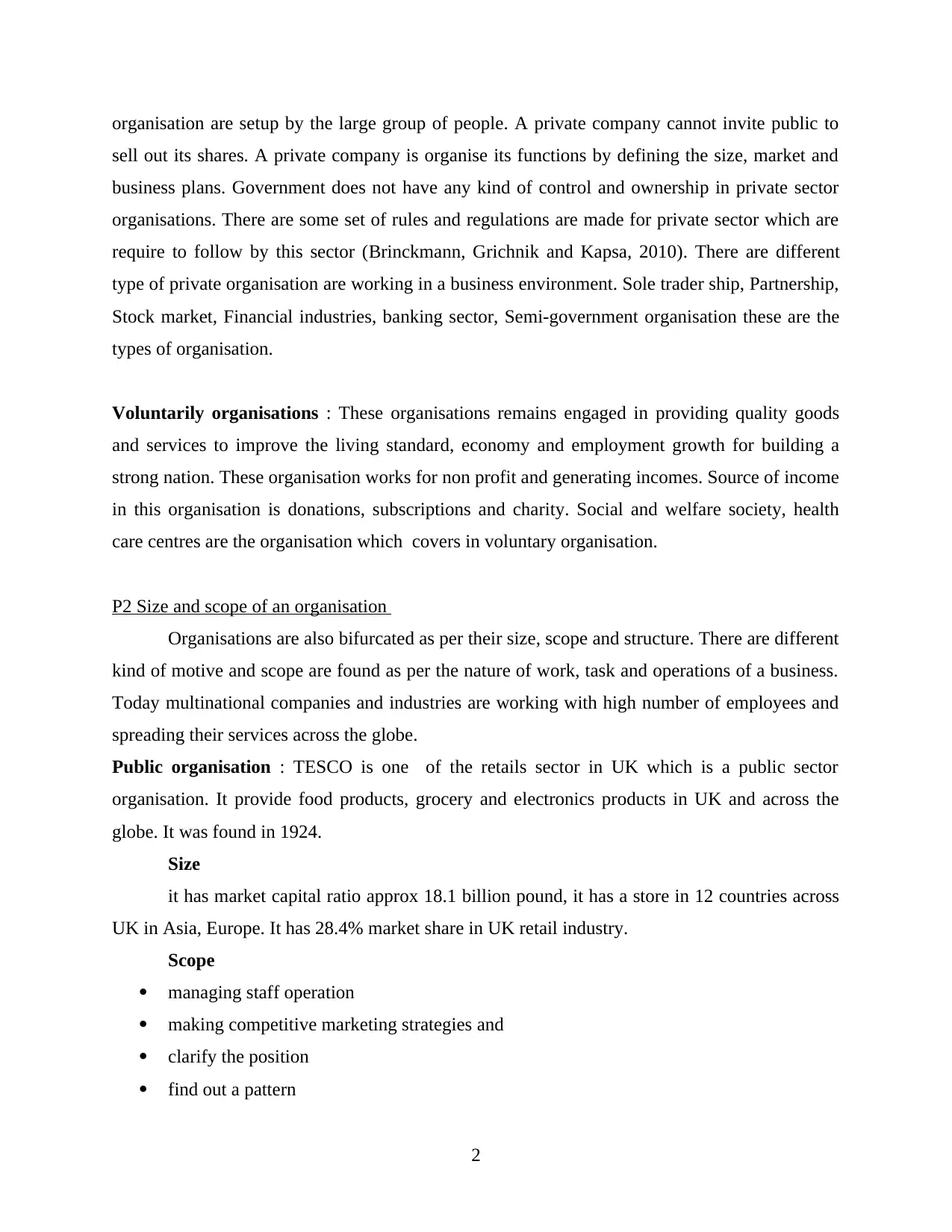
organisation are setup by the large group of people. A private company cannot invite public to
sell out its shares. A private company is organise its functions by defining the size, market and
business plans. Government does not have any kind of control and ownership in private sector
organisations. There are some set of rules and regulations are made for private sector which are
require to follow by this sector (Brinckmann, Grichnik and Kapsa, 2010). There are different
type of private organisation are working in a business environment. Sole trader ship, Partnership,
Stock market, Financial industries, banking sector, Semi-government organisation these are the
types of organisation.
Voluntarily organisations : These organisations remains engaged in providing quality goods
and services to improve the living standard, economy and employment growth for building a
strong nation. These organisation works for non profit and generating incomes. Source of income
in this organisation is donations, subscriptions and charity. Social and welfare society, health
care centres are the organisation which covers in voluntary organisation.
P2 Size and scope of an organisation
Organisations are also bifurcated as per their size, scope and structure. There are different
kind of motive and scope are found as per the nature of work, task and operations of a business.
Today multinational companies and industries are working with high number of employees and
spreading their services across the globe.
Public organisation : TESCO is one of the retails sector in UK which is a public sector
organisation. It provide food products, grocery and electronics products in UK and across the
globe. It was found in 1924.
Size
it has market capital ratio approx 18.1 billion pound, it has a store in 12 countries across
UK in Asia, Europe. It has 28.4% market share in UK retail industry.
Scope
managing staff operation
making competitive marketing strategies and
clarify the position
find out a pattern
2
sell out its shares. A private company is organise its functions by defining the size, market and
business plans. Government does not have any kind of control and ownership in private sector
organisations. There are some set of rules and regulations are made for private sector which are
require to follow by this sector (Brinckmann, Grichnik and Kapsa, 2010). There are different
type of private organisation are working in a business environment. Sole trader ship, Partnership,
Stock market, Financial industries, banking sector, Semi-government organisation these are the
types of organisation.
Voluntarily organisations : These organisations remains engaged in providing quality goods
and services to improve the living standard, economy and employment growth for building a
strong nation. These organisation works for non profit and generating incomes. Source of income
in this organisation is donations, subscriptions and charity. Social and welfare society, health
care centres are the organisation which covers in voluntary organisation.
P2 Size and scope of an organisation
Organisations are also bifurcated as per their size, scope and structure. There are different
kind of motive and scope are found as per the nature of work, task and operations of a business.
Today multinational companies and industries are working with high number of employees and
spreading their services across the globe.
Public organisation : TESCO is one of the retails sector in UK which is a public sector
organisation. It provide food products, grocery and electronics products in UK and across the
globe. It was found in 1924.
Size
it has market capital ratio approx 18.1 billion pound, it has a store in 12 countries across
UK in Asia, Europe. It has 28.4% market share in UK retail industry.
Scope
managing staff operation
making competitive marketing strategies and
clarify the position
find out a pattern
2
Paraphrase This Document
Need a fresh take? Get an instant paraphrase of this document with our AI Paraphraser
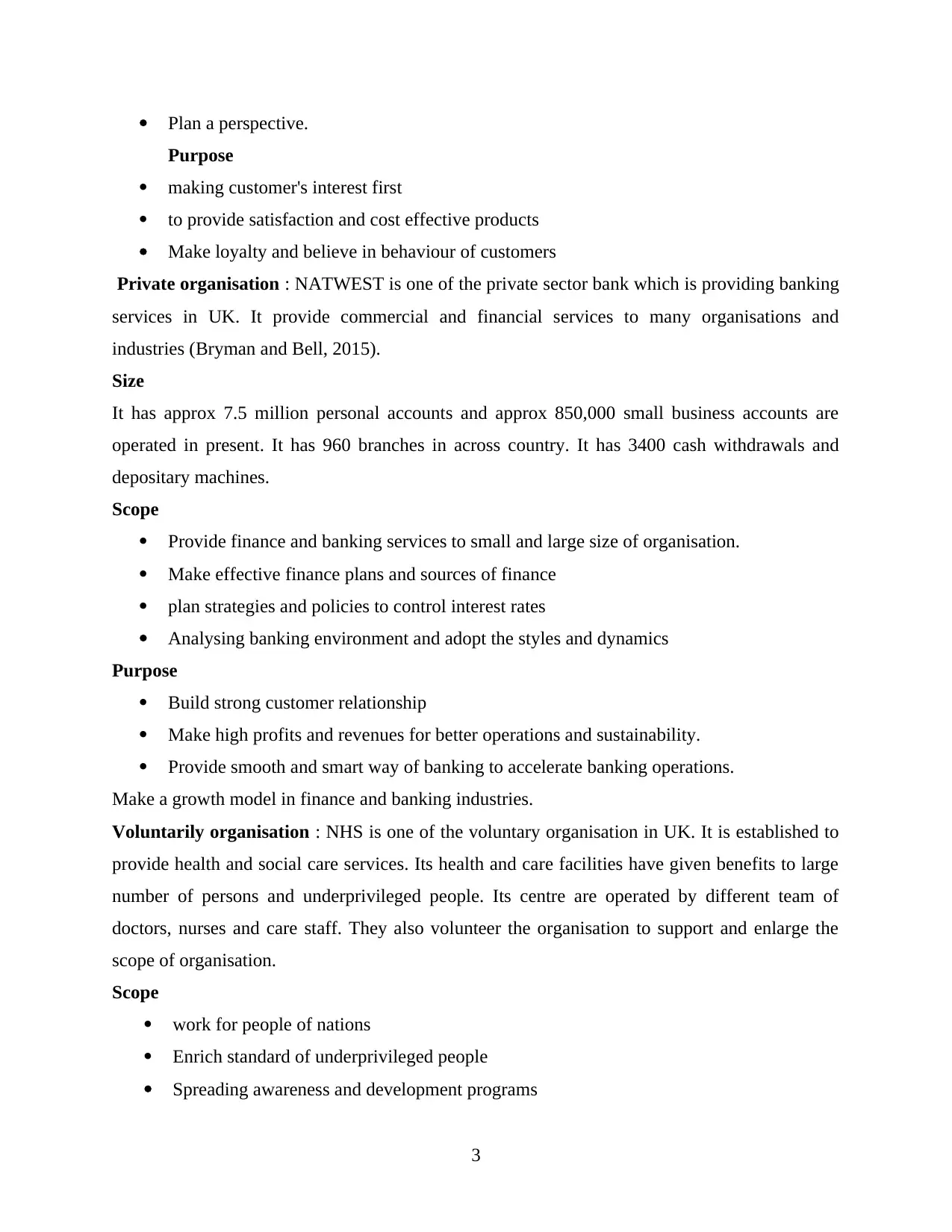
Plan a perspective.
Purpose
making customer's interest first
to provide satisfaction and cost effective products
Make loyalty and believe in behaviour of customers
Private organisation : NATWEST is one of the private sector bank which is providing banking
services in UK. It provide commercial and financial services to many organisations and
industries (Bryman and Bell, 2015).
Size
It has approx 7.5 million personal accounts and approx 850,000 small business accounts are
operated in present. It has 960 branches in across country. It has 3400 cash withdrawals and
depositary machines.
Scope
Provide finance and banking services to small and large size of organisation.
Make effective finance plans and sources of finance
plan strategies and policies to control interest rates
Analysing banking environment and adopt the styles and dynamics
Purpose
Build strong customer relationship
Make high profits and revenues for better operations and sustainability.
Provide smooth and smart way of banking to accelerate banking operations.
Make a growth model in finance and banking industries.
Voluntarily organisation : NHS is one of the voluntary organisation in UK. It is established to
provide health and social care services. Its health and care facilities have given benefits to large
number of persons and underprivileged people. Its centre are operated by different team of
doctors, nurses and care staff. They also volunteer the organisation to support and enlarge the
scope of organisation.
Scope
work for people of nations
Enrich standard of underprivileged people
Spreading awareness and development programs
3
Purpose
making customer's interest first
to provide satisfaction and cost effective products
Make loyalty and believe in behaviour of customers
Private organisation : NATWEST is one of the private sector bank which is providing banking
services in UK. It provide commercial and financial services to many organisations and
industries (Bryman and Bell, 2015).
Size
It has approx 7.5 million personal accounts and approx 850,000 small business accounts are
operated in present. It has 960 branches in across country. It has 3400 cash withdrawals and
depositary machines.
Scope
Provide finance and banking services to small and large size of organisation.
Make effective finance plans and sources of finance
plan strategies and policies to control interest rates
Analysing banking environment and adopt the styles and dynamics
Purpose
Build strong customer relationship
Make high profits and revenues for better operations and sustainability.
Provide smooth and smart way of banking to accelerate banking operations.
Make a growth model in finance and banking industries.
Voluntarily organisation : NHS is one of the voluntary organisation in UK. It is established to
provide health and social care services. Its health and care facilities have given benefits to large
number of persons and underprivileged people. Its centre are operated by different team of
doctors, nurses and care staff. They also volunteer the organisation to support and enlarge the
scope of organisation.
Scope
work for people of nations
Enrich standard of underprivileged people
Spreading awareness and development programs
3
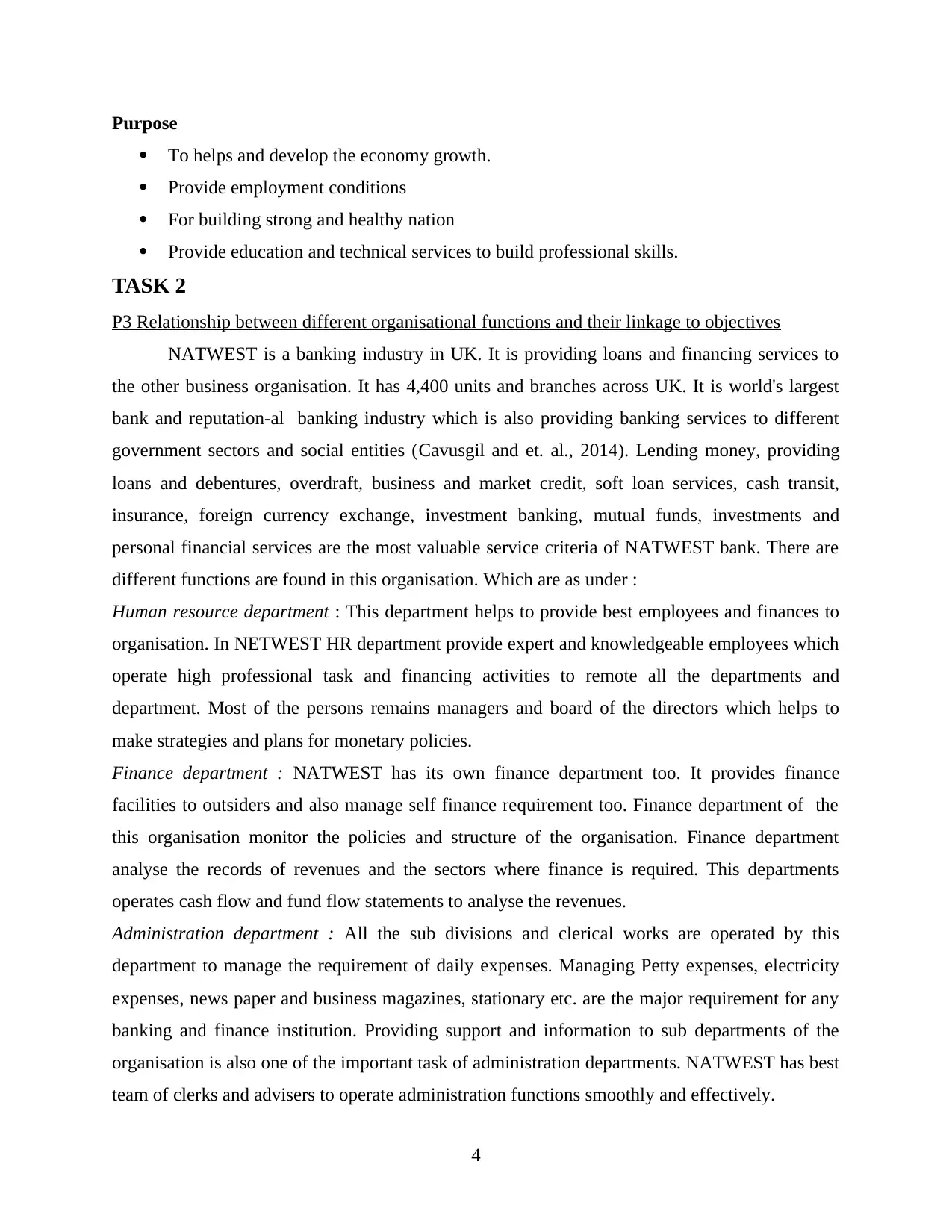
Purpose
To helps and develop the economy growth.
Provide employment conditions
For building strong and healthy nation
Provide education and technical services to build professional skills.
TASK 2
P3 Relationship between different organisational functions and their linkage to objectives
NATWEST is a banking industry in UK. It is providing loans and financing services to
the other business organisation. It has 4,400 units and branches across UK. It is world's largest
bank and reputation-al banking industry which is also providing banking services to different
government sectors and social entities (Cavusgil and et. al., 2014). Lending money, providing
loans and debentures, overdraft, business and market credit, soft loan services, cash transit,
insurance, foreign currency exchange, investment banking, mutual funds, investments and
personal financial services are the most valuable service criteria of NATWEST bank. There are
different functions are found in this organisation. Which are as under :
Human resource department : This department helps to provide best employees and finances to
organisation. In NETWEST HR department provide expert and knowledgeable employees which
operate high professional task and financing activities to remote all the departments and
department. Most of the persons remains managers and board of the directors which helps to
make strategies and plans for monetary policies.
Finance department : NATWEST has its own finance department too. It provides finance
facilities to outsiders and also manage self finance requirement too. Finance department of the
this organisation monitor the policies and structure of the organisation. Finance department
analyse the records of revenues and the sectors where finance is required. This departments
operates cash flow and fund flow statements to analyse the revenues.
Administration department : All the sub divisions and clerical works are operated by this
department to manage the requirement of daily expenses. Managing Petty expenses, electricity
expenses, news paper and business magazines, stationary etc. are the major requirement for any
banking and finance institution. Providing support and information to sub departments of the
organisation is also one of the important task of administration departments. NATWEST has best
team of clerks and advisers to operate administration functions smoothly and effectively.
4
To helps and develop the economy growth.
Provide employment conditions
For building strong and healthy nation
Provide education and technical services to build professional skills.
TASK 2
P3 Relationship between different organisational functions and their linkage to objectives
NATWEST is a banking industry in UK. It is providing loans and financing services to
the other business organisation. It has 4,400 units and branches across UK. It is world's largest
bank and reputation-al banking industry which is also providing banking services to different
government sectors and social entities (Cavusgil and et. al., 2014). Lending money, providing
loans and debentures, overdraft, business and market credit, soft loan services, cash transit,
insurance, foreign currency exchange, investment banking, mutual funds, investments and
personal financial services are the most valuable service criteria of NATWEST bank. There are
different functions are found in this organisation. Which are as under :
Human resource department : This department helps to provide best employees and finances to
organisation. In NETWEST HR department provide expert and knowledgeable employees which
operate high professional task and financing activities to remote all the departments and
department. Most of the persons remains managers and board of the directors which helps to
make strategies and plans for monetary policies.
Finance department : NATWEST has its own finance department too. It provides finance
facilities to outsiders and also manage self finance requirement too. Finance department of the
this organisation monitor the policies and structure of the organisation. Finance department
analyse the records of revenues and the sectors where finance is required. This departments
operates cash flow and fund flow statements to analyse the revenues.
Administration department : All the sub divisions and clerical works are operated by this
department to manage the requirement of daily expenses. Managing Petty expenses, electricity
expenses, news paper and business magazines, stationary etc. are the major requirement for any
banking and finance institution. Providing support and information to sub departments of the
organisation is also one of the important task of administration departments. NATWEST has best
team of clerks and advisers to operate administration functions smoothly and effectively.
4
⊘ This is a preview!⊘
Do you want full access?
Subscribe today to unlock all pages.

Trusted by 1+ million students worldwide
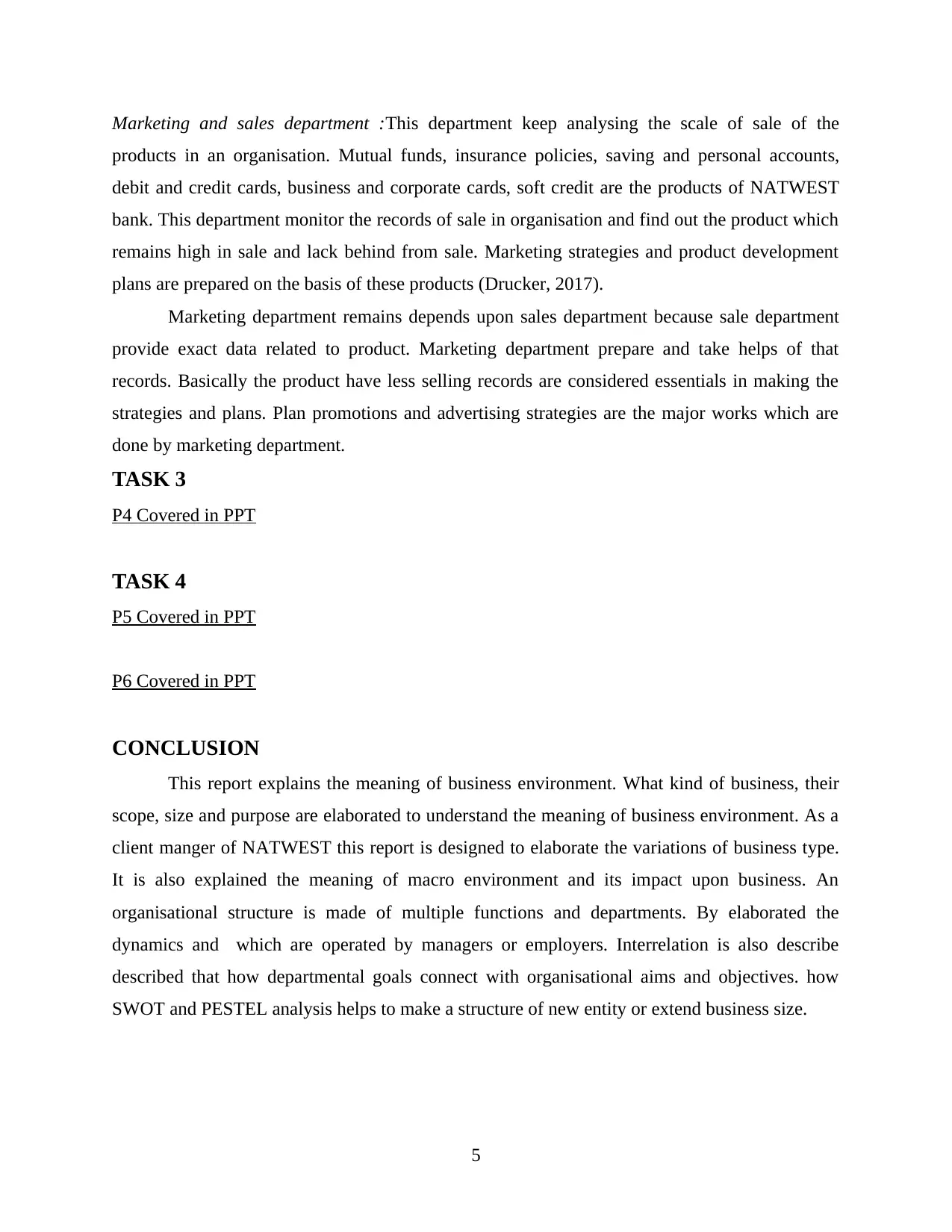
Marketing and sales department :This department keep analysing the scale of sale of the
products in an organisation. Mutual funds, insurance policies, saving and personal accounts,
debit and credit cards, business and corporate cards, soft credit are the products of NATWEST
bank. This department monitor the records of sale in organisation and find out the product which
remains high in sale and lack behind from sale. Marketing strategies and product development
plans are prepared on the basis of these products (Drucker, 2017).
Marketing department remains depends upon sales department because sale department
provide exact data related to product. Marketing department prepare and take helps of that
records. Basically the product have less selling records are considered essentials in making the
strategies and plans. Plan promotions and advertising strategies are the major works which are
done by marketing department.
TASK 3
P4 Covered in PPT
TASK 4
P5 Covered in PPT
P6 Covered in PPT
CONCLUSION
This report explains the meaning of business environment. What kind of business, their
scope, size and purpose are elaborated to understand the meaning of business environment. As a
client manger of NATWEST this report is designed to elaborate the variations of business type.
It is also explained the meaning of macro environment and its impact upon business. An
organisational structure is made of multiple functions and departments. By elaborated the
dynamics and which are operated by managers or employers. Interrelation is also describe
described that how departmental goals connect with organisational aims and objectives. how
SWOT and PESTEL analysis helps to make a structure of new entity or extend business size.
5
products in an organisation. Mutual funds, insurance policies, saving and personal accounts,
debit and credit cards, business and corporate cards, soft credit are the products of NATWEST
bank. This department monitor the records of sale in organisation and find out the product which
remains high in sale and lack behind from sale. Marketing strategies and product development
plans are prepared on the basis of these products (Drucker, 2017).
Marketing department remains depends upon sales department because sale department
provide exact data related to product. Marketing department prepare and take helps of that
records. Basically the product have less selling records are considered essentials in making the
strategies and plans. Plan promotions and advertising strategies are the major works which are
done by marketing department.
TASK 3
P4 Covered in PPT
TASK 4
P5 Covered in PPT
P6 Covered in PPT
CONCLUSION
This report explains the meaning of business environment. What kind of business, their
scope, size and purpose are elaborated to understand the meaning of business environment. As a
client manger of NATWEST this report is designed to elaborate the variations of business type.
It is also explained the meaning of macro environment and its impact upon business. An
organisational structure is made of multiple functions and departments. By elaborated the
dynamics and which are operated by managers or employers. Interrelation is also describe
described that how departmental goals connect with organisational aims and objectives. how
SWOT and PESTEL analysis helps to make a structure of new entity or extend business size.
5
Paraphrase This Document
Need a fresh take? Get an instant paraphrase of this document with our AI Paraphraser
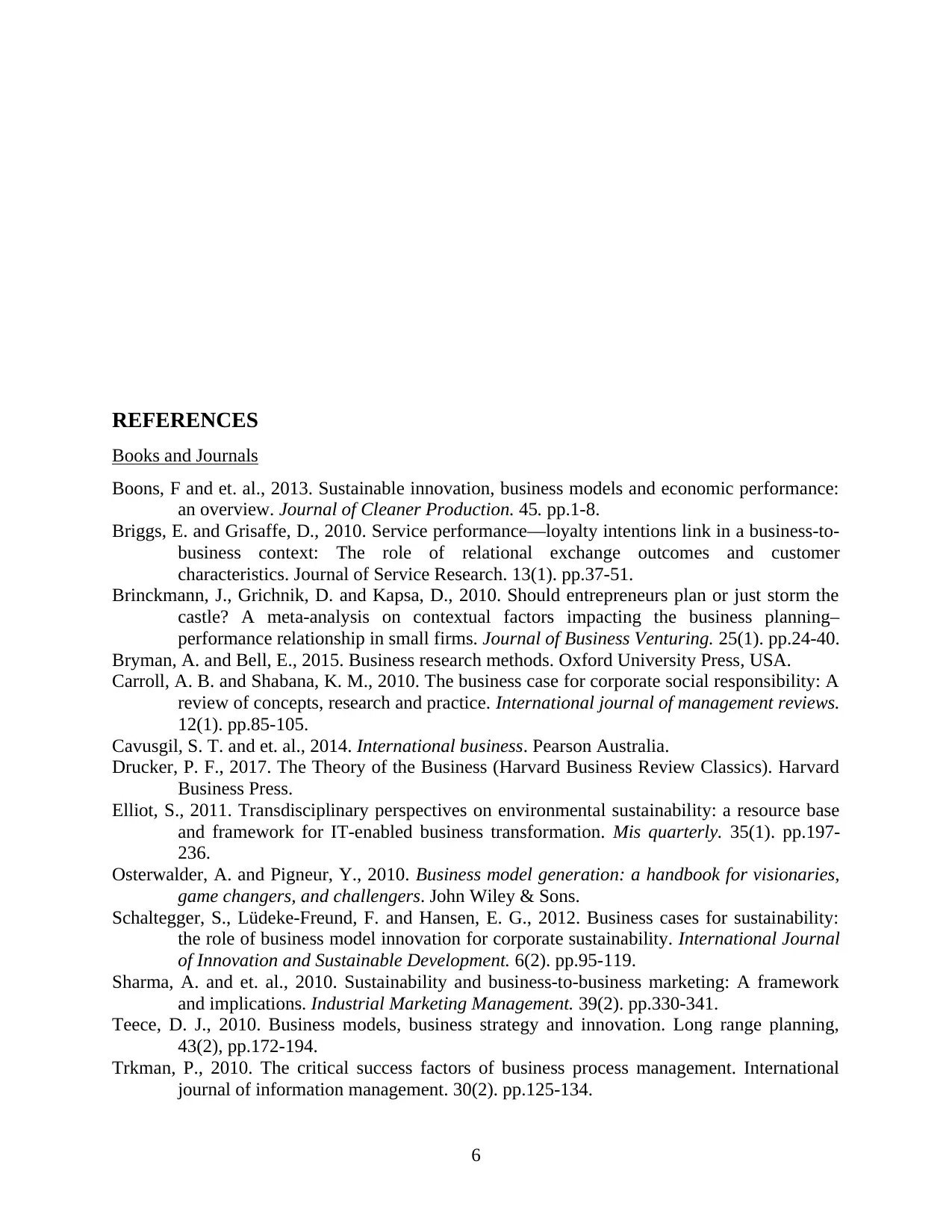
REFERENCES
Books and Journals
Boons, F and et. al., 2013. Sustainable innovation, business models and economic performance:
an overview. Journal of Cleaner Production. 45. pp.1-8.
Briggs, E. and Grisaffe, D., 2010. Service performance—loyalty intentions link in a business-to-
business context: The role of relational exchange outcomes and customer
characteristics. Journal of Service Research. 13(1). pp.37-51.
Brinckmann, J., Grichnik, D. and Kapsa, D., 2010. Should entrepreneurs plan or just storm the
castle? A meta-analysis on contextual factors impacting the business planning–
performance relationship in small firms. Journal of Business Venturing. 25(1). pp.24-40.
Bryman, A. and Bell, E., 2015. Business research methods. Oxford University Press, USA.
Carroll, A. B. and Shabana, K. M., 2010. The business case for corporate social responsibility: A
review of concepts, research and practice. International journal of management reviews.
12(1). pp.85-105.
Cavusgil, S. T. and et. al., 2014. International business. Pearson Australia.
Drucker, P. F., 2017. The Theory of the Business (Harvard Business Review Classics). Harvard
Business Press.
Elliot, S., 2011. Transdisciplinary perspectives on environmental sustainability: a resource base
and framework for IT-enabled business transformation. Mis quarterly. 35(1). pp.197-
236.
Osterwalder, A. and Pigneur, Y., 2010. Business model generation: a handbook for visionaries,
game changers, and challengers. John Wiley & Sons.
Schaltegger, S., Lüdeke-Freund, F. and Hansen, E. G., 2012. Business cases for sustainability:
the role of business model innovation for corporate sustainability. International Journal
of Innovation and Sustainable Development. 6(2). pp.95-119.
Sharma, A. and et. al., 2010. Sustainability and business-to-business marketing: A framework
and implications. Industrial Marketing Management. 39(2). pp.330-341.
Teece, D. J., 2010. Business models, business strategy and innovation. Long range planning,
43(2), pp.172-194.
Trkman, P., 2010. The critical success factors of business process management. International
journal of information management. 30(2). pp.125-134.
6
Books and Journals
Boons, F and et. al., 2013. Sustainable innovation, business models and economic performance:
an overview. Journal of Cleaner Production. 45. pp.1-8.
Briggs, E. and Grisaffe, D., 2010. Service performance—loyalty intentions link in a business-to-
business context: The role of relational exchange outcomes and customer
characteristics. Journal of Service Research. 13(1). pp.37-51.
Brinckmann, J., Grichnik, D. and Kapsa, D., 2010. Should entrepreneurs plan or just storm the
castle? A meta-analysis on contextual factors impacting the business planning–
performance relationship in small firms. Journal of Business Venturing. 25(1). pp.24-40.
Bryman, A. and Bell, E., 2015. Business research methods. Oxford University Press, USA.
Carroll, A. B. and Shabana, K. M., 2010. The business case for corporate social responsibility: A
review of concepts, research and practice. International journal of management reviews.
12(1). pp.85-105.
Cavusgil, S. T. and et. al., 2014. International business. Pearson Australia.
Drucker, P. F., 2017. The Theory of the Business (Harvard Business Review Classics). Harvard
Business Press.
Elliot, S., 2011. Transdisciplinary perspectives on environmental sustainability: a resource base
and framework for IT-enabled business transformation. Mis quarterly. 35(1). pp.197-
236.
Osterwalder, A. and Pigneur, Y., 2010. Business model generation: a handbook for visionaries,
game changers, and challengers. John Wiley & Sons.
Schaltegger, S., Lüdeke-Freund, F. and Hansen, E. G., 2012. Business cases for sustainability:
the role of business model innovation for corporate sustainability. International Journal
of Innovation and Sustainable Development. 6(2). pp.95-119.
Sharma, A. and et. al., 2010. Sustainability and business-to-business marketing: A framework
and implications. Industrial Marketing Management. 39(2). pp.330-341.
Teece, D. J., 2010. Business models, business strategy and innovation. Long range planning,
43(2), pp.172-194.
Trkman, P., 2010. The critical success factors of business process management. International
journal of information management. 30(2). pp.125-134.
6
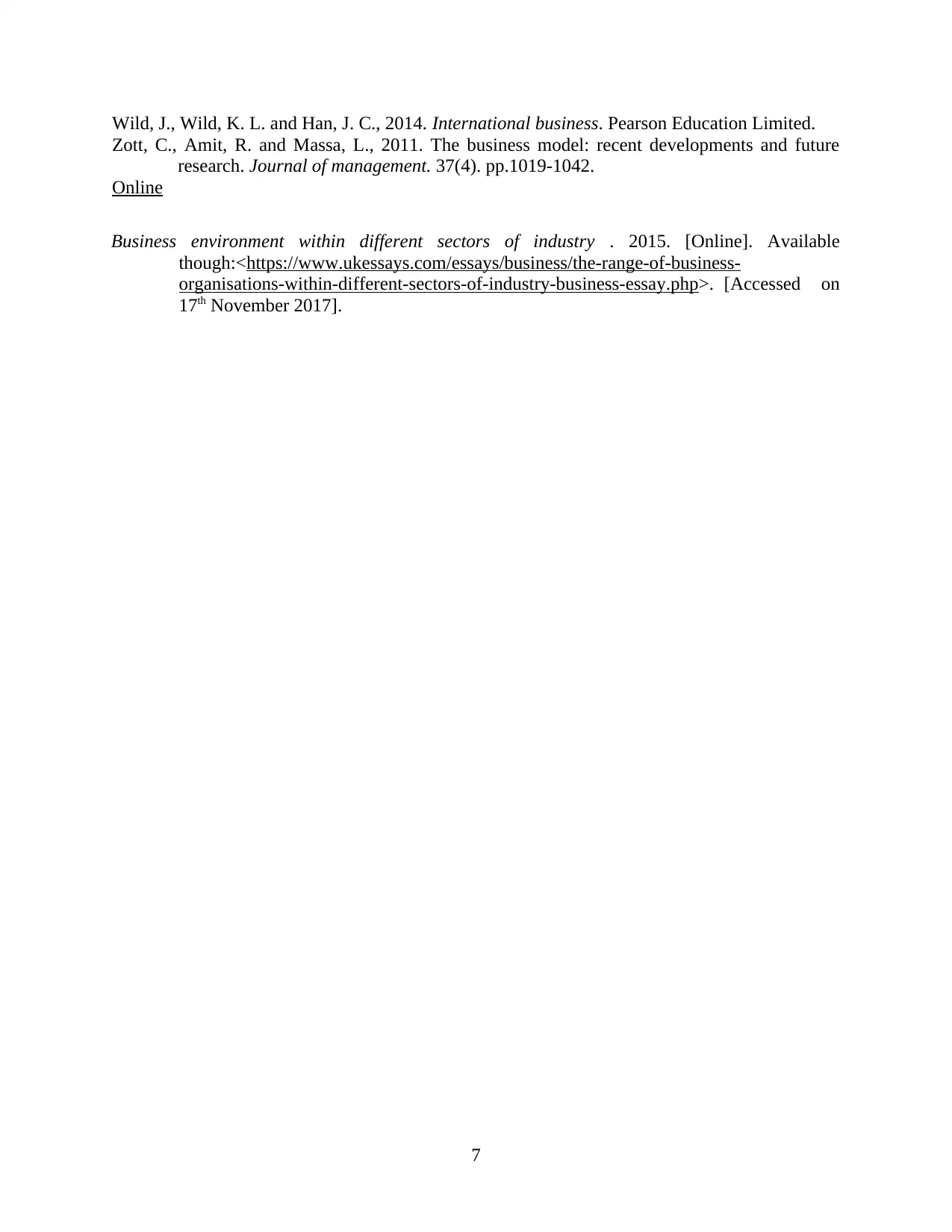
Wild, J., Wild, K. L. and Han, J. C., 2014. International business. Pearson Education Limited.
Zott, C., Amit, R. and Massa, L., 2011. The business model: recent developments and future
research. Journal of management. 37(4). pp.1019-1042.
Online
Business environment within different sectors of industry . 2015. [Online]. Available
though:<https://www.ukessays.com/essays/business/the-range-of-business-
organisations-within-different-sectors-of-industry-business-essay.php>. [Accessed on
17th November 2017].
7
Zott, C., Amit, R. and Massa, L., 2011. The business model: recent developments and future
research. Journal of management. 37(4). pp.1019-1042.
Online
Business environment within different sectors of industry . 2015. [Online]. Available
though:<https://www.ukessays.com/essays/business/the-range-of-business-
organisations-within-different-sectors-of-industry-business-essay.php>. [Accessed on
17th November 2017].
7
⊘ This is a preview!⊘
Do you want full access?
Subscribe today to unlock all pages.

Trusted by 1+ million students worldwide
1 out of 9
Related Documents
Your All-in-One AI-Powered Toolkit for Academic Success.
+13062052269
info@desklib.com
Available 24*7 on WhatsApp / Email
![[object Object]](/_next/static/media/star-bottom.7253800d.svg)
Unlock your academic potential
Copyright © 2020–2025 A2Z Services. All Rights Reserved. Developed and managed by ZUCOL.





